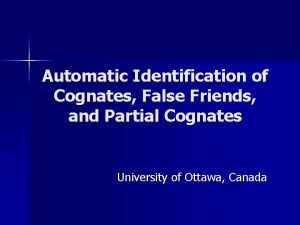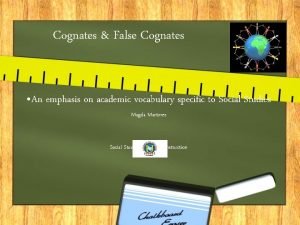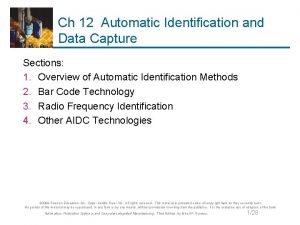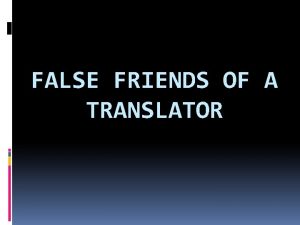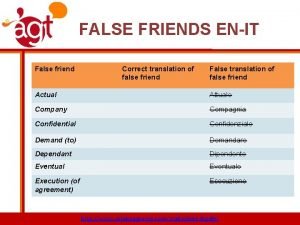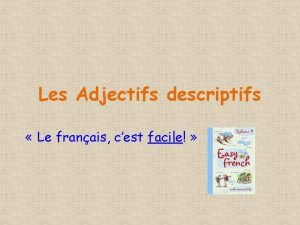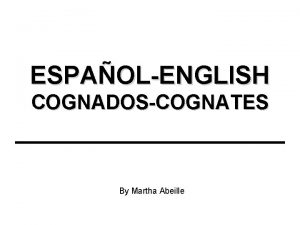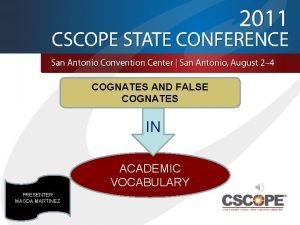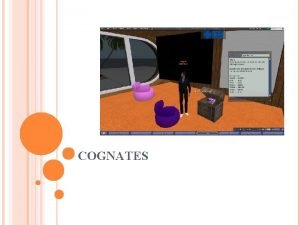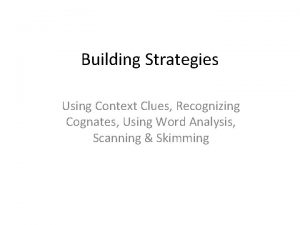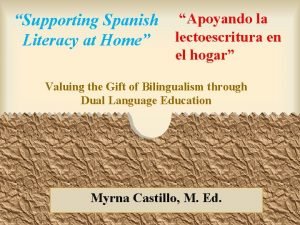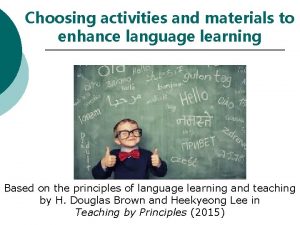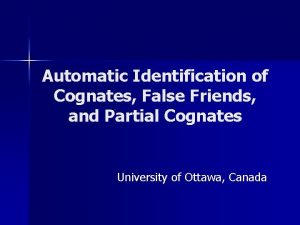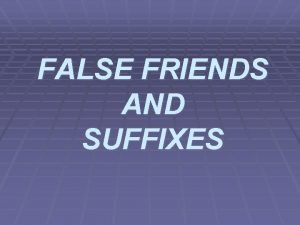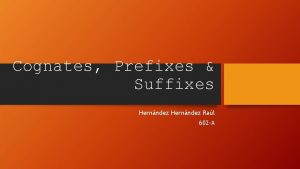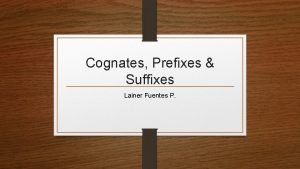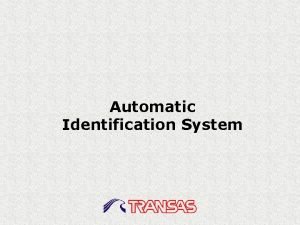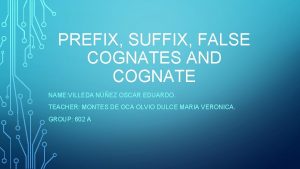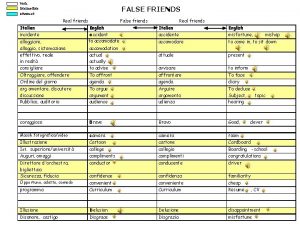Automatic Identification of Cognates False Friends and Partial























- Slides: 23

Automatic Identification of Cognates, False Friends, and Partial Cognates University of Ottawa, Canada

Outline Overview of the Thesis n Research Contribution n Cognate and False Friend Identification n Partial Cognate Disambiguation n CLPA- Cognate and False Friend Annotator n Conclusions and Future Work n

Overview of the Thesis Tasks – Automatic Identification of Cognates and False Friends – Automatic Disambiguation of Partial Cognates Areas of Applications – CALL, MT, Word Alignment, Cross-Language Information Retrieval CALL Tool - CLPA

Definitions n Cognates or True Friends (Vrais Amis), are pairs of n False Friends (Faux Amis) are pairs of words in two n Partial Cognates words that share the same meaning words that are perceived as similar and are mutual translations. nature - nature, reconnaissance - recognition languages that are perceived as similar but have different meanings. main (=hand) - main (principal, essential), blesser (=to injure) - bless (bénir in French) in two languages in some but not all contexts note – note, facteur - factor or mailman, maker

Research Contribution n Novel method based on ML algorithms to identify Cognates and False Friends n A method to create complete lists of Cognates and False Friends n Define a novel task: Partial Cognate Disambiguation, and solve it using a supervised and a semi-supervised method – Combine and use corpora from different domains n Implement a CALL Tool – CLPA to annotate Cognates and False Friends

Cognates and False Friends Identification n Our method – Machine Learning techniques with different algorithms – Instances: French-English pairs of words – Feature Space: 13 orthographic similarity measures – Classes: Cog_FF and Unrelated Experiments done for: n Each measure separately n Average of all measures n All 13 measures

Cognates and False Friends Identification n Data Cognates Training set Test set 613 (73) 603 (178) False-Friends 314 (135) 94 (46) Unrelated 527 (0) 343 (0) Total 1454 1040

Results for classification (COG_FF/UNREL) Orthographic similarity measure Threshold Accuracy on Training set Accuracy on Test set IDENT 1 43. 90 % 55. 00 % PREFIX 0. 03845 92. 70 % 90. 97 % DICE 0. 29669 89. 40 % 93. 37 % LCSR 0. 45800 92. 91 % 94. 24 % NED 0. 34845 93. 39 % 93. 57 % SOUNDEX 0. 62500 85. 28 % 84. 54 % TRI 0. 0476 88. 30 % 92. 13 % XDICE 0. 21825 92. 84 % 94. 52 % XXDICE 0. 12915 91. 74 % 95. 39 % TRI-SIM 0. 34845 95. 66 % 93. 28 % TRI-DIST 0. 34845 95. 11 % 93. 85 % Average measure 0. 14770 93. 83 % 94. 14 %

Results for classification (COG_FF/UNREL) Classifier Accuracy crossval. on training set Accuracy on test set Baseline 63. 75 % 66. 98 % One. Rule 95. 66 % 92. 89 % Naive Bayes 94. 84 % 94. 62 % Decision Tree 95. 66 % 92. 08 % Decision Tree (pruned) 95. 66% 93. 18 % IBK 93. 81 % 92. 80 % Ada Boost 95. 66 % 93. 47 % Perceptron 95. 11 % 91. 55 % SVM (SMO) 95. 46 % 93. 76 %

Complete Lists of Cognates and False Friends n Method – Use the XXDICE orthographic similarity measure – Use list of pairs of words in two languages (the words that are translation of each other, or not, or monolingual lists of words) – Use a bilingual dictionary to determine if the words contained in a pair are translation of each other

Complete Lists of Cognates and False Friends n Evaluation – On the entry list of a French-English bilingual dictionary n n – 55% - Cognates 2% - False Friends (5, 619, 270 pairs) We created pair of words from two large monolingual list of words in French and English n 11, 469, 662 – Orthographical Similar (0. 8%) – 3, 496 Cognates (0. 03%) – 3, 767, 435 False Friends (32%)

Cognates and False Friends Identification Conclusion n We tested a number of orthographic similarity measures individually, and also combined using different Machine Learning algorithms n We evaluated the methods on a training set using 10 -fold cross validation, on a test set n We proposed an extension of the method to create complete lists of Cognates and False Friends n The results show that, for French and English, it is possible to achieve very good accuracy based on the orthographic measures of word similarity

Partial Cognate Disambiguation n Task – To determine the sense/meaning (Cognate or False Friend with the equivalent English word) of an Partial Cognate in a French context Note Cog Le comité prend note de cette information. The Committee takes note of this reply. FF Mais qui a dû payer la note? So who got left holding the bill?

Data n Use a set of 10 Partial Cognates – Parallel sentences that have on the French side the French Partial Cognate and on the English side the English Cognate (English False Friend) labeled as COG (FF) n Collected from Euro. Par, Hansard – ~ 115 sentences each class for Training – ~ 60 sentences each class for Testing

Supervised Method Traditional ML algorithms Features - used the bag-of-words (BOW) approach of modeling context, with the binary feature values - context words from the training corpus that appeared at least 3 times in the training sentences Classes COG and FF

Monolingual Bootstrapping For each pair of partial cognates (PC) 1. Train a classifier on the training seeds – using the BOW approach and a NB-K classifier with attribute selection on the features 2. Apply the classifier on unlabeled data – sentences that contain the PC word, extracted from Le. Monde (MB-F) or from BNC (MB-E) 3. Take the first k newly classified sentences, both from the COG and FF class and add them to the training seeds (the most confident ones – the prediction accuracy greater or equal than a threshold =0. 85) 4. Rerun the experiments training on the new training set 5. Repeat steps 2 and 3 for t times end. For

Bilingual Bootstrapping 1. Translate the English sentences that were collected in the MB-E step into French using an online MT tool and add them to the French seed training data. 2. Repeat the MB-F and MB-E steps for T times.

Additional Data n Le. Monde – An average of 250 sentences for each class n BNC – An average of 200 sentences for each class n Multi-Domain corpus – An average of 80 sentences for each class

Results

Partial Cognate Disambiguation Conclusions – Simple methods and available tools are used with success for a task hard to solve even for humans – Additional use of unlabeled learning process for the Disambiguation task data improves the Partial Cognates – Semi-Supervised Learning proves to be “as good as” Supervised Learning

CLPA-Cross Language Pair Annotator

Future Work n Apply the Cognate and False Friend Identification method, and create complete list for other pair of languages n Increase the accuracy results for the Partial Cognate Disambiguation task n Use lemmatization for French texts and human evaluation for CLPA

Thank you!
 Partial false friends
Partial false friends Cognata
Cognata Cognados regulares
Cognados regulares Automatic identification and data capture pdf
Automatic identification and data capture pdf Faithful and false friends in translation
Faithful and false friends in translation Slidetodoc.com
Slidetodoc.com Little friends may prove to be great friends
Little friends may prove to be great friends Suffix to friend
Suffix to friend False friends
False friends True or false true or false
True or false true or false Positive identification
Positive identification Adjectifs descriptifs
Adjectifs descriptifs What are cognates?
What are cognates? These are techniques or activities that contribute directly
These are techniques or activities that contribute directly Example of cognates
Example of cognates Spanish cognates that end in cion
Spanish cognates that end in cion Strategy: recognizing cognates
Strategy: recognizing cognates What are cognates?
What are cognates? Apoyando in english
Apoyando in english Cognates in spanish
Cognates in spanish Automated input device
Automated input device Having good friends who love and support you
Having good friends who love and support you Family and friends 2 what are you wearing
Family and friends 2 what are you wearing For parents and friends radiation threat
For parents and friends radiation threat
